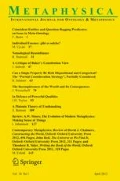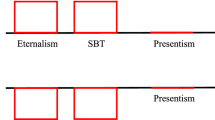Abstract
The three alternative ontological theories of time are introduced as well as the three basic temporal phenomena. The different ontological analyses by the different theories are compared and examined. A relational theory of time is advocated as a result of the examination, and an influential misrepresentation and emendation of it by McTaggart is criticized and diagnosed as hyperdynamism. Finally, the problem of the direction of time is addressed. The physicist’s solutions are rejected, and an ontological solution is offered.
Similar content being viewed by others
Notes
The claim of Hanson and Feyerabend that observation in science is theory-laden is not wrong but their relativist conclusions are. Objectivity can be achieved by means of theoretical pluralism.
Newton 1972, Definitio VII, Scholium I.
Aristotle 1989 p.96, the difficulty is also the gist of Zeno’s Arrow Argument.
Brentano 1976 p.96 footn.; one has to know that Brentano associates existence and justified acknowledgement.
Newton does not analyze tenses. What Aristotle says in Physics 219b about the now is not relevant because, on the one hand, he identifies it with the time-points and, on the other hand, considers it a persisting substratum.
An ontological grounding of the direction of a relation can be found in Tegtmeier 1992, Chap.V.
References
Aristoteles. Physikvorlesung. Academie, Berlin. 1989
Bergmann, G. Logic and Reality. University of Wisconsin Press, Madison 1964
Brentano, F. Kategorienlehre. Meiner, Hamburg 1974
Brentano, F. Philosophische Untersuchungen zu Raum, Zeit und Kontinuum. Meiner, Hamburg 1976
Dietze, G. Untersuchungen über den Umfang des Bewußtseins bei regelmäßig aufeinanderfolgenden Schalleindrücken. In: Philosophische Studien 2 (1885)
Fraisse, P. Psychologie der Zeit. München, Basel 1985
Leibniz, G.W. Philosophische Schriften. Bd.VII. Hildesheim, Olms 1961
McTaggart, J.M.E. Philosophical Studies. London, Arnold 1934
McTaggart, J.M.E. The Nature of Existence. Vol.II. Grosse Pointe, Michigan. 1968
Newton, I. Philosophiae naturalis principa mathematica. Harvard University Press, Cambridge 1972
Platon. Sämtliche Werke 5. Hamburg 1959
Russell, B. Principles of Mathematics. 2nd ed. Allen and Unwin, London 1937
Tegtmeier, E. Grundzüge einer kategorialen Ontologie. Alber, Freiburg 1992
Tegtmeier, E. The Direction of Time: A Problem of Ontology, not of Physics, in: J.Faye (Hrsg.) Perspectives on Time. Dordrecht 1996
Tegtmeier, E. Parmenides’ Problem of Becoming and its Solution. Logical Analysis and History of Philosophy 2:51–65 (1999)
Author information
Authors and Affiliations
Corresponding author
About this article
Cite this article
Tegtmeier, E. Ontology of Time and Hyperdynamism. Int Ontology Metaphysics 10, 185–198 (2009). https://doi.org/10.1007/s12133-009-0050-6
Published:
Issue Date:
DOI: https://doi.org/10.1007/s12133-009-0050-6




